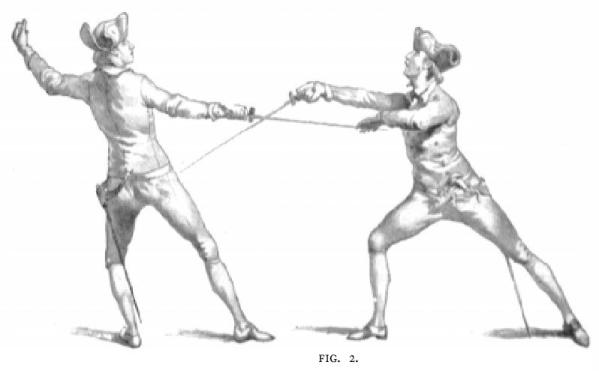Fencing, Old and New. *
As Typified by Angelo and Prévost.
Journal of Western Martial Art
April 2003
by H. A. Colmore Dunn
Originally published in Outing magazine, October, 1894, No. 25, p. 29-34.
The present method of fencing which is wholly given over to the use of the point, is thus based upon and developed out of a system which was mainly concerned in the consideration of the edge. It is by reason of this double element in the growth of fencing, in the limited sense of management of the point, that the exercise is regarded as the best prelude to the study of all hand-to-hand
that Bertrand, although trained up from his earliest years in the strictest academical discipline, yet, by reason of the tumultuous audacity of the man, he was able to hold his own, and more, against the wild fantastic style of those with whom he was brought into contact in his first assaults, the followers of the new “romantisme” whose one idea was to touch anywhere and anyhow, and who

weapons. Many of the parries used in fencing are identical in point of position with those employed in sabre play, and in particular, may be said to belong more properly to the latter than the former. In using parries such as quarte, tierce and seconde, to stop a cut, much more force is required to give them sufficient authority than in warding off thrust; yet it is only the application that is different; the principle of their formation is the same.
Under the old system of fencing, as Angelo takes occasion to lament the theoretical side of the art was still in its infancy, though the practical part had been brought to a high degree of perfection. Even if it be not possible for modern masters to criticise the theory of fencing in Angelo’s time, still since his day very much has been done by professors such as Gomard and Grisier to give the theory that clearness and exactitude which is characteristic of the best French work in all its phases, so that, at the present time, or turning to the treatise of M. Camille Prévost, on whom, in a sense, the mantle of the famous Bertrand has fallen, it is hard to see how any essential improvement could be brought about. In a delightful little sketch of the career of Bertrand by M. E. Legouvé, prefixed to M. Camille Prévot's “Théorie pratique de l’escrime," he states
could not bear the restraints of the classical school. Bertrand, the assimilator of such diverse, antagonistic elements, unfortunately left no written memorial, and M. Pierre Prévost, who was one of Bertrand’s pupils and a great fencer, left only a little work, was written in English and published in 1860. The object of this work was to reduce the theory of fencing to its lowest terms, leaving only the essential principles. M. Camille Prévost can therefore claim to speak with his father’s voice, and also adds to the weight of his own opinions by embodying the views handed down to him from Bertrand, who, according to the same sketch, introduced many improvements in the riposte, timing, etc. Although there have been numerous changes and innovations between Angelo and Prévost, these have taken in great measure the shape of rejecting superfluous movements and of developing that which already existed in the germ. The foundations of Angelo were secure and have lasted, though much of the ornament of the superstructure has been cut away. For example, nothing could be clearer than this: “Chaque botte a sa parade et chaque riposte. La parade est la principale parade sa partie des armes.
Journal of Western Martial Art
April 2003